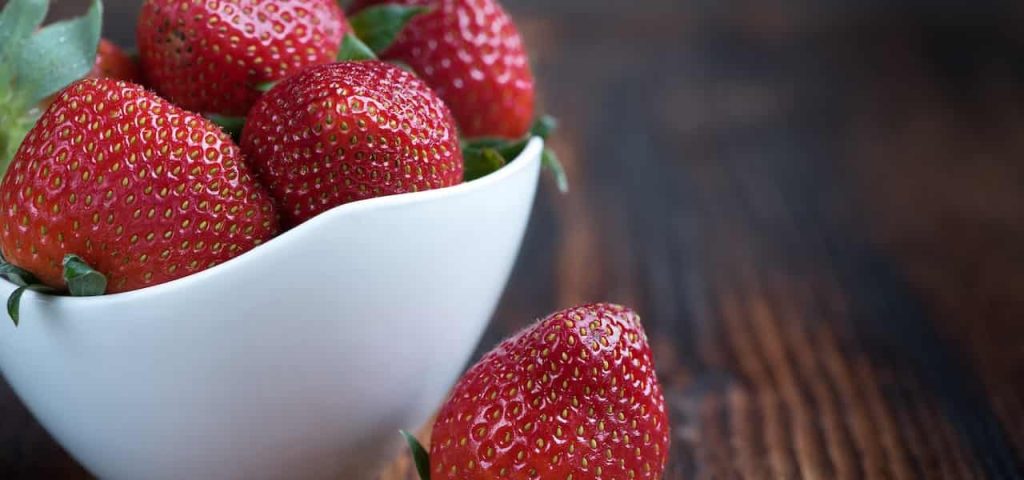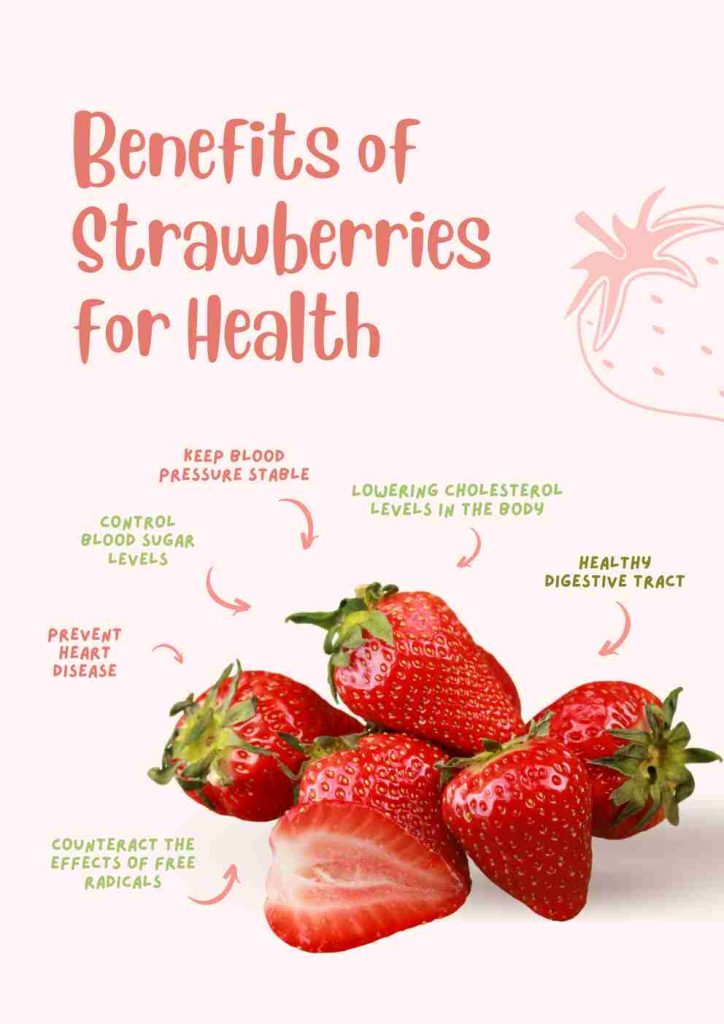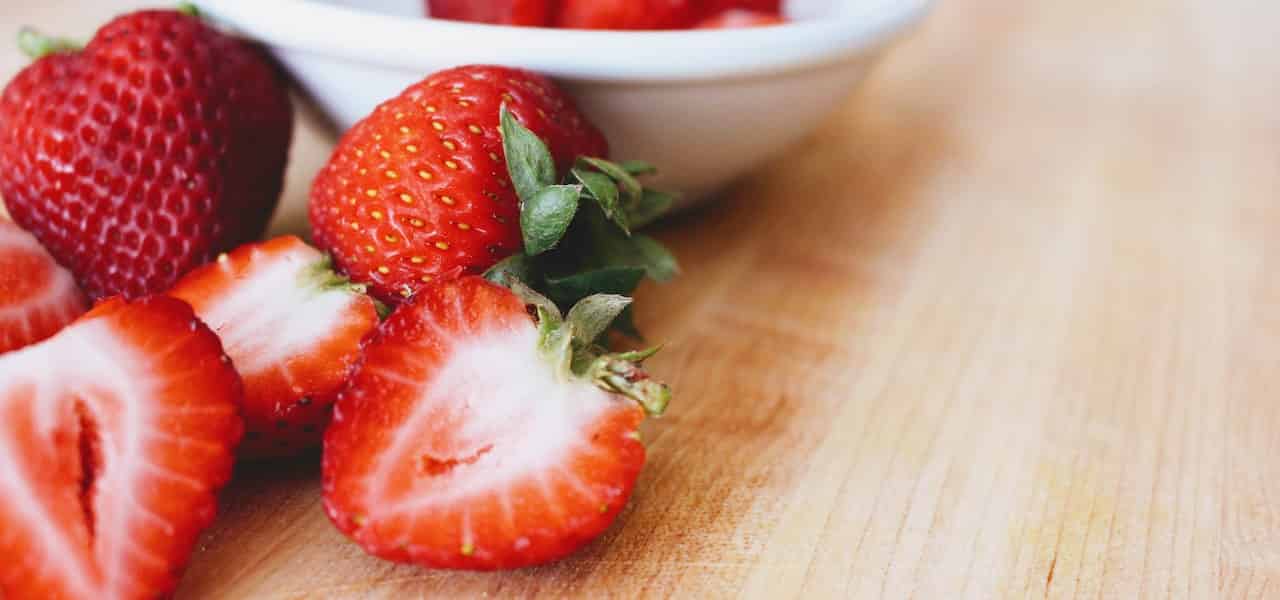Here is your complete guide to nutrition facts of strawberries.
Introduction to Nutrition Facts Of Strawberries
Strawberries, with their vibrant red hue and luscious taste, are not just a delicious fruit but also a nutritional powerhouse. Packed with essential vitamins, minerals, and antioxidants, these berries offer a multitude of health benefits. In this comprehensive guide, we delve into the nutritional facts of strawberries and explore how they can enhance your well-being. Get ready to uncover the secrets behind the succulent sweetness of strawberries! Here is your complete guide to the nutrition facts of strawberries. So What you need to know about the nutrition facts of strawberries.
Nutrition Facts of Strawberries
| Nutrient | Amount per 100g |
|---|---|
| Calories | 32 |
| Carbohydrates | 7.7g |
| Fiber | 2g |
| Protein | 0.7g |
| Fat | 0.3g |
| Vitamin C | 58.8mg |
| Vitamin K | 2.2mcg |
| Folate (Vitamin B9) | 24mcg |
| Potassium | 153mg |
| Manganese | 0.4mg |
| Magnesium | 13mg |
The Powerhouse of Vitamins and Minerals
When it comes to vitamins and minerals, strawberries are an exceptional source. These little red gems contain a significant amount of vitamin C, a powerful antioxidant known for its immune-boosting properties. Additionally, strawberries are rich in vitamin K, which plays a vital role in blood clotting and bone health. Moreover, they are a great source of vitamin B9, also known as folate, which is essential for cell growth and development.
Strawberries are not just about vitamins; they also offer an array of minerals. Potassium, for instance, is crucial for maintaining healthy blood pressure levels and supporting heart function. Manganese, another mineral found abundantly in strawberries, aids in the metabolism of carbohydrates, proteins, and cholesterol. Lastly, magnesium, a mineral involved in numerous enzymatic reactions, contributes to bone health and muscle function.

Health Benefits of Strawberries
| Health Benefit | Description |
|---|---|
| Antioxidant Powerhouse | Strawberries are rich in antioxidants, including anthocyanins, ellagic acid, and quercetin, which help protect the body against free radicals, reduce inflammation, and prevent chronic diseases. |
| Heart Health | The combination of antioxidants, potassium, and fiber in strawberries supports heart health by reducing cholesterol levels, regulating blood pressure, and promoting overall cardiovascular well-being. |
| Immune System Support | The high vitamin C content in strawberries strengthens the immune system, aids in the production of white blood cells, and protects against infections. |
| Weight Management | Strawberries are low in calories, high in fiber, and provide a feeling of fullness, making them a beneficial addition to a weight management plan by promoting satiety and controlling calorie intake. |
| Digestive Health | The fiber content in strawberries promotes healthy digestion, regular bowel movements, and prevents constipation. |
| Skin Health | Antioxidants in strawberries help protect the skin from oxidative stress, contribute to collagen production, and promote healthy and glowing skin. |
| Eye Health | The antioxidants found in strawberries, such as vitamin C and ellagic acid, may help prevent age-related macular degeneration and promote good vision. |
| Anti-Inflammatory Effects | The antioxidants and phytochemicals in strawberries possess anti-inflammatory properties that can help reduce inflammation in the body and support overall well-being. |
| Bone Health | Strawberries contain minerals like manganese, which plays a role in maintaining bone health and density. |
| Cognitive Function | Some studies suggest that the antioxidants in strawberries may have a positive impact on brain function, memory, and cognitive performance. |

Antioxidants Galore
Strawberries are loaded with antioxidants, making them a true gift from nature. These antioxidants, including anthocyanins, ellagic acid, and quercetin, help protect the body against harmful free radicals. By neutralizing these free radicals, strawberries assist in reducing inflammation and combating oxidative stress, which can contribute to chronic diseases.
The presence of antioxidants in strawberries has been linked to various health benefits. Research suggests that these compounds may help improve heart health by reducing cholesterol levels and preventing the oxidation of LDL (bad) cholesterol. Furthermore, the powerful antioxidants in strawberries have shown promising anticancer properties, potentially inhibiting the growth of tumor cells and protecting against certain types of cancers.
Fiber and Digestive Health
In addition to their impressive vitamin and antioxidant content, strawberries are also an excellent source of dietary fiber. Fiber plays a crucial role in maintaining a healthy digestive system. It adds bulk to the stool, promotes regular bowel movements, and prevents constipation.
Moreover, the fiber in strawberries contributes to managing blood sugar levels. It slows down the absorption of sugar, preventing spikes and crashes and promoting stable energy levels throughout the day. Additionally, the high fiber content aids in weight management by providing a feeling of fullness, thereby reducing overall calorie intake.
Heart Health and Blood Pressure
Strawberries have long been associated with cardiovascular health benefits. The antioxidants, potassium, and fiber found in strawberries contribute to maintaining a healthy heart and reducing the risk of cardiovascular diseases.
Antioxidants help protect the heart by reducing inflammation and preventing the oxidation of cholesterol, which can lead to plaque buildup in the arteries. Potassium, on the other hand, supports heart function by regulating blood pressure levels and reducing the risk of strokes. Strawberries, with their combination of antioxidants and potassium, make a delicious and heart-healthy addition to any diet.
Immunity Boosting
When it comes to supporting the immune system, strawberries are a fantastic choice. Vitamin C, abundant in these berries, is well-known for its role in immune function. It aids in the production of white blood cells, which are essential for fighting off infections and diseases. Vitamin C also acts as a potent antioxidant, protecting cells from damage caused by free radicals.
In addition to vitamin C, strawberries contain other nutrients that contribute to immune health. Manganese, for instance, plays a crucial role in the production of antioxidant enzymes that help neutralize free radicals and support the immune system’s defense mechanisms. The combination of vitamin C, manganese, and other antioxidants found in strawberries makes them a valuable fruit for strengthening the immune system and promoting overall well-being.
Weight Management and Metabolism
If you’re looking to manage your weight or boost your metabolism, strawberries can be your secret weapon. With their low calorie content and high fiber content, these berries are an excellent choice for those aiming to shed some pounds.
The fiber in strawberries adds bulk to your meals, making you feel fuller for longer. This helps reduce overeating and unnecessary snacking, ultimately contributing to weight management. Additionally, the high fiber content aids in regulating digestion and promoting a healthy gut, which plays a crucial role in maintaining overall well-being.
Moreover, strawberries may have a positive impact on metabolism. Some studies suggest that certain compounds in strawberries, such as ellagic acid, may help enhance fat-burning processes in the body. While strawberries alone won’t magically melt away the pounds, incorporating them into a balanced diet can certainly support your weight management goals.
How Strawberries Help with Weight Loss
| Benefit | Description |
|---|---|
| Low in Calories | Strawberries are low in calories, allowing you to enjoy a satisfying portion without consuming excessive calories. |
| High in Fiber | The high fiber content in strawberries promotes feelings of fullness, reduces hunger cravings, and helps control calorie intake. |
| Promotes Satiety | Including strawberries in your meals or snacks can help you feel satisfied for longer, reducing the desire to overeat or snack on unhealthy options. |
| Low Glycemic Index | Strawberries have a low glycemic index, meaning they have a minimal impact on blood sugar levels, making them suitable for maintaining stable energy levels and controlling cravings. |
| Hydration Support | With their high water content, strawberries contribute to overall hydration, which is essential for a well-functioning metabolism and weight management. |
| Nutrient Density | Despite being low in calories, strawberries are rich in essential nutrients, ensuring you get vital vitamins and minerals while keeping your calorie intake in check. |
| Versatile and Healthy | Strawberries can be enjoyed in various ways, making them a versatile also healthy option for weight loss. Add them to smoothies, salads, or enjoy them as a guilt-free snack. |
FAQs About Nutrition Facts Of Strawberries
What is the nutritional value of strawberries?
Strawberries are packed with essential vitamins, minerals, and antioxidants. Here’s a breakdown of their nutritional value per 100 grams:
- Calories: 32
- Carbohydrates: 7.7 grams
- Fiber: 2 grams
- Protein: 0.7 grams
- Fat: 0.3 grams
- Vitamin C: 58.8 milligrams (98% of the daily recommended intake)
- Vitamin K: 2.2 micrograms (3% of the daily recommended intake)
- Folate (Vitamin B9): 24 micrograms (6% of the daily recommended intake)
- Potassium: 153 milligrams
- Manganese: 0.4 milligrams
- Magnesium: 13 milligrams
What are 7 strawberry nutrition facts?
Here are seven interesting nutrition facts about strawberries:
- Excellent Source of Vitamin C: Strawberries are one of the best sources of vitamin C, providing nearly 100% of the daily recommended intake per 100 grams.
- Rich in Antioxidants: Strawberries are packed with antioxidants like anthocyanins, ellagic acid, and quercetin, which help protect the body against free radicals and inflammation.
- Low in Calories: With only 32 calories per 100 grams, strawberries are a guilt-free snack or addition to meals.
- High in Fiber: Strawberries contain approximately 2 grams of fiber per 100 grams, aiding in digestion and promoting satiety.
- Heart-Healthy: The combination of antioxidants and potassium in strawberries supports heart health by reducing cholesterol levels and regulating blood pressure.
- Immune-Boosting: The high vitamin C content of strawberries strengthens the immune system and helps fight off infections.
- Cancer-Fighting Properties: Some studies suggest that the antioxidants and phytochemicals found in strawberries may help inhibit the growth of cancer cells.
Read More About Calories in a Boiled Egg.
How many strawberries should you eat a day?
There is no set number of strawberries that everyone should eat per day as it depends on individual dietary needs also preferences. However, including a serving of strawberries, which is roughly 1 cup or about 8-10 medium-sized berries, in your daily diet can be a healthy choice. Strawberries are a low-calorie fruit packed with essential nutrients, so incorporating them into a balanced diet can be beneficial.
Read More About the Benefits of Good Morning Exercise.
What are 8 strawberry nutrition facts?
Here are eight more intriguing nutrition facts about strawberries:
- Blood Sugar Regulation: The fiber content in strawberries helps regulate blood sugar levels, making them a suitable choice for individuals with diabetes or those looking to manage their blood glucose.
- Eye Health: Strawberries contain antioxidants like vitamin C and ellagic acid, which may help prevent age-related macular degeneration and promote healthy vision.
- Hydration: With a water content of approximately 91%, strawberries contribute to overall hydration, supporting various bodily functions.
- Anti-Inflammatory Benefits: The antioxidants and phytochemicals in strawberries possess anti-inflammatory properties that can help reduce inflammation in the body.
- Bone Health: Strawberries contain minerals like manganese, which plays a role in maintaining bone health and density.
- Skin Health: The antioxidants in strawberries contribute to healthy skin by protecting against oxidative stress and promoting collagen production.
- Cognitive Function: Some studies suggest that the antioxidants found in strawberries may help improve brain function and delay age-related cognitive decline.
- Nutrient Absorption: The presence of vitamin C in strawberries aids in the absorption of iron from plant-based sources, enhancing overall iron utilization in the body.
Read More About The Ultimate Warm-Up Routine for a Killer Back Workout.
Conclusion
Strawberries are more than just a delectable fruit; they are a nutritional powerhouse brimming with vitamins, minerals, antioxidants, and fiber. From supporting heart health and immune function to aiding in weight management and digestion, these vibrant berries offer a wide array of health benefits.
Read More About The Power of Proper Nutrition.
Incorporating strawberries into your diet is easy and enjoyable. You can savor them on their own, add them to smoothies, toss them in salads, or use them as a topping for yogurt or oatmeal. The possibilities are endless!
Read More About The Ultimate Nutrition Facts of Plums.
So, the next time you bite into a juicy strawberry, remember the incredible nutritional value it brings to your body. Indulge in these sweet delights while reaping the numerous health benefits they offer. Whether you’re looking to boost your immune system, support heart health, or maintain a healthy weight, strawberries are a tasty also nutritious addition to your daily routine.
Read Also: The Surprising Health Benefit of Celery Tea.
Make strawberries a part of your life and unlock the nutritional wonders they hold. Your taste buds and your body will thank you for it!

